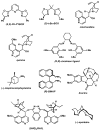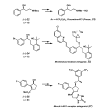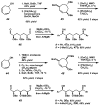The palladium-catalyzed aerobic kinetic resolution of secondary alcohols: reaction development, scope, and applications
- PMID: 19904777
- PMCID: PMC2862982
- DOI: 10.1002/chem.200902172
The palladium-catalyzed aerobic kinetic resolution of secondary alcohols: reaction development, scope, and applications
Abstract
The first palladium-catalyzed enantioselective oxidation of secondary alcohols has been developed, utilizing the readily available diamine (-)-sparteine as a chiral ligand and molecular oxygen as the stoichiometric oxidant. Mechanistic insights regarding the role of the base and hydrogen-bond donors have resulted in several improvements to the original system. Namely, addition of cesium carbonate and tert-butyl alcohol greatly enhances reaction rates, promoting rapid resolutions. The use of chloroform as solvent allows the use of ambient air as the terminal oxidant at 23 degrees C, resulting in enhanced catalyst selectivity. These improved reaction conditions have permitted the successful kinetic resolution of benzylic, allylic, and cyclopropyl secondary alcohols to high enantiomeric excess with good-to-excellent selectivity factors. This catalyst system has also been applied to the desymmetrization of meso-diols, providing high yields of enantioenriched hydroxyketones.
Figures

















Similar articles
-
Scope of enantioselective palladium(II)-catalyzed aerobic alcohol oxidations with (-)-sparteine.J Org Chem. 2003 May 30;68(11):4600-3. doi: 10.1021/jo0269161. J Org Chem. 2003. PMID: 12762783
-
Palladium-catalyzed enantioselective oxidation of alcohols: a dramatic rate acceleration by Cs2CO3/t-BuOH.Org Lett. 2003 Mar 20;5(6):835-7. doi: 10.1021/ol027463p. Org Lett. 2003. PMID: 12633084
-
Highly selective palladium catalyzed kinetic resolution and enantioselective substitution of racemic allylic carbonates with sulfur nucleophiles: asymmetric synthesis of allylic sulfides, allylic sulfones, and allylic alcohols.Chemistry. 2003 Sep 5;9(17):4202-21. doi: 10.1002/chem.200204657. Chemistry. 2003. PMID: 12953206
-
Acid-base catalysis of chiral Pd complexes: development of novel catalytic asymmetric reactions and their application to synthesis of drug candidates.Chem Pharm Bull (Tokyo). 2006 Oct;54(10):1351-64. doi: 10.1248/cpb.54.1351. Chem Pharm Bull (Tokyo). 2006. PMID: 17015970 Review.
-
Electronic and Steric Tuning of a Prototypical Piano Stool Complex: Rh(III) Catalysis for C-H Functionalization.Acc Chem Res. 2018 Jan 16;51(1):170-180. doi: 10.1021/acs.accounts.7b00444. Epub 2017 Dec 22. Acc Chem Res. 2018. PMID: 29272106 Free PMC article. Review.
Cited by
-
If C-H bonds could talk: selective C-H bond oxidation.Angew Chem Int Ed Engl. 2011 Apr 4;50(15):3362-74. doi: 10.1002/anie.201006368. Epub 2011 Mar 16. Angew Chem Int Ed Engl. 2011. PMID: 21413105 Free PMC article. Review.
-
Rapid Access to Hydroxyfluoranthenes via a Domino Suzuki-Miyaura/Intramolecular Diels-Alder/Ring-Opening Reactions Sequence.J Org Chem. 2022 May 6;87(9):6336-6346. doi: 10.1021/acs.joc.1c03080. Epub 2022 Apr 7. J Org Chem. 2022. PMID: 35389218 Free PMC article.
-
Palladium(II)-catalyzed alkene functionalization via nucleopalladation: stereochemical pathways and enantioselective catalytic applications.Chem Rev. 2011 Apr 13;111(4):2981-3019. doi: 10.1021/cr100371y. Epub 2011 Mar 23. Chem Rev. 2011. PMID: 21428440 Free PMC article. Review. No abstract available.
-
A dinuclear palladium catalyst for α-hydroxylation of carbonyls with O2.J Am Chem Soc. 2011 Feb 16;133(6):1760-2. doi: 10.1021/ja108396k. Epub 2011 Jan 19. J Am Chem Soc. 2011. PMID: 21247109 Free PMC article.
-
Asymmetric synthesis of aryl/vinyl alkyl carbinol esters via Ni-catalyzed reductive arylation/vinylation of 1-chloro-1-alkanol esters.Chem Sci. 2022 Jun 27;13(28):8365-8370. doi: 10.1039/d2sc02806a. eCollection 2022 Jul 20. Chem Sci. 2022. PMID: 35919724 Free PMC article.
References
-
- Hudlicky M. Oxidations in Organic Chemistry, ACS Monograph Series. American Chemical Society; Washington, DC: 1990.
- Tidwell TT. Org React. 1990;39:297–572.
- Trost BM, Fleming I, editors. Comprehensive Organic Synthesis. Pergamon; Oxford, U.K.: 1991.
- Luzzio FA. Org React. 1998;53:1–221.
-
- Larock RC. Comprehensive Organic Transformations. Wiley & Sons; New York: 1999. pp. 1234–1248.
-
- Ohkubo K, Hirata K, Yoshinaga K, Okada M. Chem Lett. 1976:183–184.
- Berti C, Perkins MJ. Angew Chem. 1979;91:923–924.
- Angew Chem Int Ed Engl. 1979;18:864–865.
- Ishii Y, Suzuki K, Ikariya T, Saburi M, Yoshikawa S. J Org Chem. 1986;51:2822–2824.
- Ma Z, Huang Q, Bobbitt JM. J Org Chem. 1993;58:4837–4843.
- Rychnovsky SD, McLernon TL, Rajapakse H. J Org Chem. 1996;61:1194–1195.
- Kashiwagi Y, Yanagisawa Y, Kurashima F, Anzai J-i, Osa T, Bobbitt JM. Chem Commun. 1996:2745–2746. - PubMed
- Hashiguchi S, Fujii A, Haack KJ, Matsumura K, Ikariya T, Noyori R. Angew Chem. 1997;109:300–303.
- Angew Chem Int Ed Engl. 1997;36:288–289.
- Hamada T, Irie R, Mihara J, Hamachi K, Katsuki T. Tetrahedron. 1998;54:10017–10028.
- Nishibayashi Y, Takei I, Uemura S, Hidai M. Organometallics. 1999;18:2291–2293.
- Gross Z, Ini S. Org Lett. 1999;1:2077–2080.
- Kashiwagi Y, Kurashima F, Kikuchi C, Anzai J-i, Osa T, Bobbitt JM. Tetrahedron Lett. 1999;40:6469–6472.
- Masutani K, Uchida T, Irie R, Katsuki T. Tetrahedron Lett. 2000;41:5119–5123.
- Kuroboshi M, Yoshihisa H, Cortona MN, Kawakami Y, Gao Z, Tanaka H. Tetrahedron Lett. 2000;41:8131–8135.
-
-
Subsequent to our initial report in this area, a number of further studies were reported, see: Shimizu H, Nakata K, Katsuki T. Chem Lett. 2002:1080–1081.Sun W, Wang H, Xia C, Li J, Zhao P. Angew Chem. 2003;115:1072–1074.Angew Chem Int Ed. 2003;42:1042–1044.Nishibayashi Y, Yamauchi A, Onodera G, Uemura S. J Org Chem. 2003;68:5875–5880.Graetz B, Rychnovsky S, Leu WH, Farmer P, Lin R. Tetrahedron: Asymmetry. 2005;16:3584–3598.Radosevich AT, Musich C, Toste FD. J Am Chem Soc. 2005;127:1090–1091.Li Z, Tang ZH, Hu XX, Xia CG. Chem Eur J. 2005;11:1210–1216.Weng SS, Shen MW, Kao JQ, Munot YS, Chen CT. Proc Natl Acad Sci USA. 2006;103:3522–3527.Pawar VD, Bettigeri S, Weng SS, Kao JQ, Chen CT. J Am Chem Soc. 2006;128:6308–6309.Li YY, Zhang XQ, Dong ZR, Shen WY, Chen G, Gao JX. Org Lett. 2006;8:5565–5567.Sun W, Wu X, Xia C. Helv Chim Acta. 2007;90:623–626.Chen T, Jiang JJ, Xu Q, Shi M. Org Lett. 2007;9:865–868.Kantam ML, Ramani T, Chakrapani L, Choudary BM. J Mol Catal A: Chem. 2007;274:11–15.Kureshy RI, Ahmad I, Pathak K, Khan N-uH, Abdi SHR, Prathap JK, Jasra RV. Chirality. 2007;19:352–357.Nakamura Y, Egami H, Matsumoto K, Uchida T, Katsuki T. Tetrahedron. 2007;63:6383–6387.Pathak K, Ahmad I, Abdi SHR, Kureshy RI, Khan N-uH, Jasra RV. J Mol Catal A: Chem. 2007;274:120–126.Onomura O, Arimoto H, Matsumura Y, Demizu Y. Tetrahedron Lett. 2007;48:8668–8672.Arita S, Koike T, Kayaki Y, Ikariya T. Angew Chem. 2008;120:2481–2483.Angew Chem Int Ed. 2008;47:2447–2449.Tomizawa M, Shibuya M, Iwabuchi Y. Org Lett. 2009;11:1829–1831.
-
-
- Stoltz BM. Chem Lett. 2004;33:362–367.
Publication types
MeSH terms
Substances
Grants and funding
LinkOut - more resources
Full Text Sources

